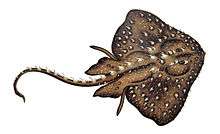Thorny skate
| Thorny skate | |
|---|---|
 | |
| Scientific classification | |
| Kingdom: | Animalia |
| Phylum: | Chordata |
| Class: | Chondrichthyes |
| Order: | Rajiformes |
| Family: | Rajidae |
| Genus: | Amblyraja |
| Species: | A. radiata |
| Binomial name | |
| Amblyraja radiata (Donovan, 1808) | |
The thorny skate (Amblyraja radiata) is a species of fish in Rajidae family. It mainly lives near the bottom of the coastline of North Atlantic Ocean in depths ranging from 20 to 1000 metres and temperatures from 1 to 10 degrees Celsius. It was also located in Lake Melville, near Goose Bay, Labrador. Rivers empty into the lake and the lake bottom is mostly made up of sand. Thorny skates have been caught in this lake in the 1980s by ice fishermen when outside temperatures were -30 degrees C.
Species Description

The length of its body and tail is generally slightly less than 1 meter and width is about half a meter. Its underside is smooth, but the upper side is, as the name suggest, very rough with many small thorns all over and 13-17 larger ones in line from the back of the head to end of the tail. The top side is brown with possibly black spots and the underside is white. It has a hard, roughly triangular snout and a tail, which is shorter than its body. It eats crustaceans, small fishes and worms. It produces egg capsules, which are 3.4-8.9 cm long and 2.3-6.8 cm wide, which hatch outside the body. It was originally named Raja radiata.
Conservation status
Thorny skate are taken as bycatch in some fisheries. It is a U.S. National Marine Fisheries Service Species of Concern. Species of Concern are those species about which the U.S. Government’s National Oceanic and Atmospheric Administration, National Marine Fisheries Service (NMFS), has some concerns regarding status and threats, but for which insufficient information is available to indicate a need to list the species under the U.S. Endangered Species Act.
References
- http://www.fishbase.org/Summary/SpeciesSummary.php?id=2565#
- http://www.flmnh.ufl.edu/fish/Gallery/Descript/ThornySkate/ThornySkate.html
